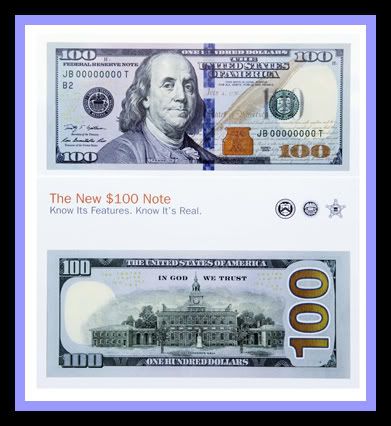
a sign of the times…..
As a metaphor for our troubled economic and financial era — and the government’s stumbling response — this one’s hard to beat. You can’t stimulate the economy via the money supply, after all, if you can’t print the money correctly.Because of a problem with the presses, the federal government has shut down production of its flashy new $100 bills, and has quarantined more than 1 billion of them — more than 10 percent of all existing U.S. cash — in a vault in Fort Worth, Texas, reports CNBC.
“There is something drastically wrong here,” one source told CNBC. “The frustration level is off the charts.”
the new design:
First Posted: 04-20-10 11:28 AM | Updated: 06-21-10 05:12 AM
(WASHINGTON– JEANNINE AVERSA and MARTIN CRUTSINGER, AP) The folks who print America’s money have designed a high-tech makeover of the $100 bill. It’s part of an effort to stay ahead of counterfeiters as technology becomes more sophisticated and more dollars flow overseas, Federal Reserve Chairman Ben Bernanke says.
The makeover, unveiled Wednesday by Bernanke and Treasury Secretary Timothy Geithner, may leave people wondering if there’s magic involved.
Benjamin Franklin is still on the C-note. But he has been joined by a disappearing Liberty Bell in an inkwell and a bright blue security ribbon composed of thousands of tiny lenses that magnify objects in mysterious ways. Move the bill, and the objects move in a different direction.
The new currency will not go into circulation until Feb. 10 of next year. That will give the government time to educate the public in the United States and around the world about the changes.
“We estimate that as many as two-thirds of all $100 notes circulate outside the United States,” said Bernanke, who stressed that the 6.5 billion in $100 bills now in circulation will remain legal tender.
The $100 bill, the highest value denomination in general circulation, is the last bill to undergo an extensive redesign. The Bureau of Engraving and Printing began the process in 2003, adding splashes of color to spruce up first the $20 and then the $50, $10 and $5 bills. The $1 bill isn’t getting a makeover.
The changes are aimed at thwarting counterfeiters who are armed with ever-more sophisticated computers, scanners and color copiers.
well guess what….
But the production process is so complex, it has instead foiled the government printers tasked with producing billions of the new notes.An official familiar with the situation told CNBC that 1.1 billion of the new bills have been printed, but they are unusable because of a creasing problem in which paper folds over during production, revealing a blank unlinked portion of the bill face.
A second person familiar with the situation said that at the height of the problem, as many as 30 percent of the bills rolling off the printing press included the flaw, leading to the production shut down.
The total face value of the unusable bills, $110 billion, represents more than ten percent of the entire supply of U.S. currency on the planet, which a government source said is $930 billion in banknotes. For now, the unusable bills are stored in the vaults in “cash packs” of four bundles of 4,000 each, with each pack containing 16,000 bills.
snip
Because officials don’t know how many of the 1.1 billion bills include the flaw, they have to hold them in the massive vaults until they are able to develop a mechanized system that can sort out the usable bills from the defects.Sorting such a huge quantity of bills by hand, the officials estimate, could take between 20 and 30 years. Using a mechanized system, they think they could sort the massive pile of bills, each of which features the familiar image of Benjamin Franklin on the face, in about one year.
The defective bills – which could number into the tens of millions, potentially representing billions of dollars in face value – will have to be burned, they say. American taxpayers have already spent an enormous amount of money to print the bills.
According to a person familiar with the matter, the bills are the most costly ever produced, with a per-note cost of about 12 cents – twice the cost of a conventional bill. That means the government spent about $120 million to produce bills it can’t use. On top of that, it is not yet clear how much more it will cost to sort the existing horde of hundred dollar bills.
The problem with the new hundred-dollar bills has remained largely hidden from public view, despite a press release issued by the Federal Reserve on Oct. 1 that announced “a delay in the issue date” of the new bills and cited “a problem with sporadic creasing of the paper.”
The redesigned bills are the first $100 bills to feature Treasury Secretary Tim Geithner’s signature. But to stave off a cash crunch as existing $100 bills deteriorate and can’t be replaced, the Federal Reserve has ordered renewed production of the current-design $100 bills, which feature Bush Treasury Secretary Hank Paulson’s signature and do not have the new security features.
Officials say that is an important step, because there are 6.6 billion $100 notes in circulation at any given time, and they wear out quickly. Reprinting the current design bills will prevent any disruption in the global circulation of US currency.
http://www.msnbc.msn.com/id/40…
alright, maybe i’m seeing monsters under the bed but….
does anyone else think this is an easy way to steal money?

3 comments
Author
they don’t bother to hide anymore, do they?
Not Work right!